Last Updated on March 22, 2023
Drywall mud is a paste-like material used to fill in the gaps between drywall panels and is usually made up of a mixture of gypsum powder and water. But, can you spray drywall mud through a paint sprayer?
Before you start spraying drywall mud with a paint sprayer, make sure it’s thinned down by mixing with just enough water so that pumping through goes smoothly and without any drips or clogs.
Achieve perfect, professional-looking results for your mudding and drywall projects with the help of our comprehensive guide. We provide all the info you need to use a paint sprayer like an expert, from detailed steps on how to apply mud via this tool through to helpful tips that guarantee optimal performance outcomes.
How Can You Spray Drywall Mud Through a Paint Sprayer: In Steps
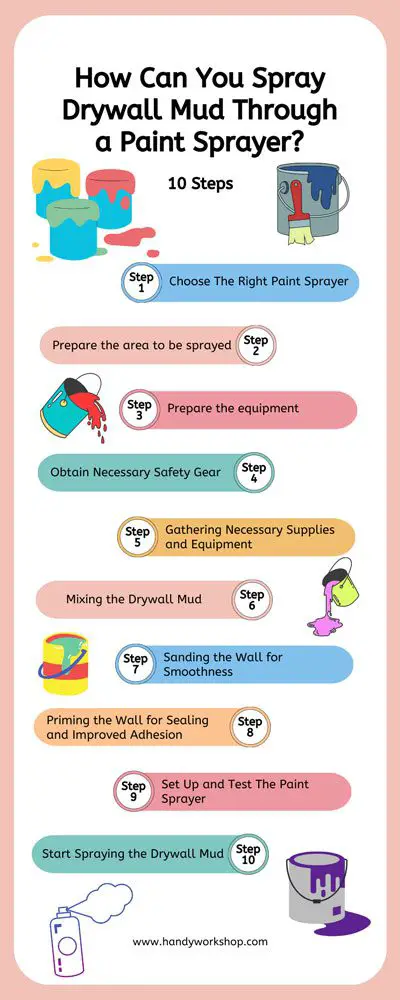
Step 01. Choose The Right Paint Sprayer
An airless paint sprayer is recommended for spraying drywall mud as these are capable of dealing with thick materials due to their high-pressure output.
Consider the size and design of the airless sprayer, the material being sprayed, and the budget when choosing a paint sprayer to spray drywall mud, as this will determine how much pressure is needed to get an even finish on the wall.
Some airless sprayers come equipped with a hopper that can hold a large amount of material which can be beneficial when spraying large areas.
If your project is smaller in scale or you have a tighter budget, then consider using an HVLP (high volume, low pressure) sprayer, which can be used for both thin and thick materials like drywall mud.
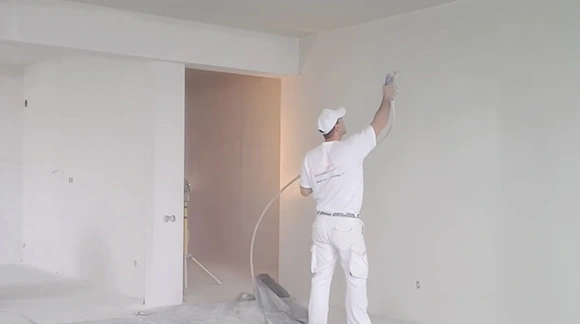
Step 02. Prepare the area to be sprayed
Before beginning any spraying project, properly prepare the surface. Clean all surfaces thoroughly with a damp cloth, as even small amounts of wet dirt or dry dust can affect how evenly and smoothly the material is applied.
Any holes or cracks should be filled in prior to spraying and dried completely before continuing further preparation steps.
Step 03. Prepare the equipment
Once you have chosen your paint sprayer and prepared the area, it’s time to start prepping your equipment. If you are using an airless paint sprayer, you must ensure that all hoses and nozzles are securely connected, then fill up your tank with water and thin down drywall mud according to manufacturer instructions.
Be sure to read all instructions carefully before beginning assembly or operation, as improper setup can lead to poor quality results or safety hazards during use.
Once everything has been connected correctly, check that all equipment components are functioning correctly before continuing to paint, as this will help reduce any potential messes from occurring during use.
Step 04. Obtain Necessary Safety Gear
Before beginning any painting project, it’s important to remember safety first. Operating a paint sprayer requires protective clothing such as goggles, respirators, and long-sleeved shirts at a minimum to reduce exposure to chemicals and particles present in the air while spraying materials like drywall mud.
It is also recommended that anyone using a paint sprayer wear earplugs or other hearing protection when operating machinery due to their loud noise levels, which can cause permanent damage if not protected adequately against it over time.
Also, ensure that there are no open flames or other sources of ignition nearby during spraying operations, as this could potentially lead to hazardous fumes being released into the environment, which could cause serious harm.
Step 05. Gathering Necessary Supplies and Equipment
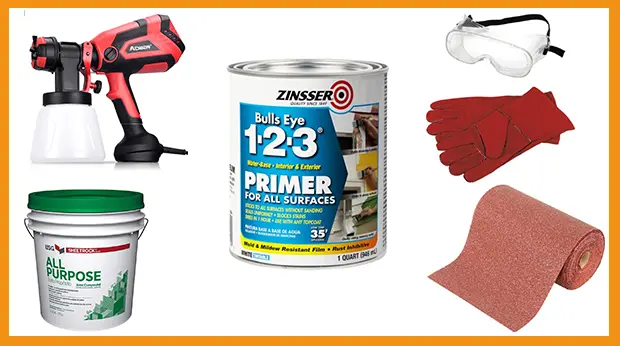
Before beginning the project of using a paint sprayer to apply the drywall mud, it is important to ensure that you have all the necessary supplies and equipment.
This includes items such as sandpaper, drywall mud, primer, a paint sprayer, goggles and gloves for safety, a drop cloth or plastic sheeting to protect the area from overspray, masking tape, and other tools for application.
Make sure to check that you have every item before beginning your project.
Step 06. Mixing the Drywall Mud
Once you have gathered the supplies and equipment, mix the drywall. The mud should be mixed according to the manufacturer’s instructions to achieve an even consistency. It is also essential to use clean tools when mixing the mud to prevent contaminating the mixture.
Ensure that the drywall mud mixture has a creamy consistency. If it is too thin or lumpy, add more powder or water accordingly until it reaches the desired consistency. Once mixed thoroughly, the drywall mud should be allowed to sit for a few minutes so it can settle properly.
Step 07. Sanding the Wall for Smoothness
After the drywall mud has had time to settle, it is essential to sand down any rough edges or bumps on the wall to ensure that they are smooth before painting. Fine-grit sandpaper should be used to avoid creating too much dust or damaging the wall surface.
After sanding down any rough patches on the wall’s surface, they should be wiped down with a damp cloth to remove any dust or debris left behind by sanding.
Step 08. Priming the Wall for Sealing and Improved Adhesion
Before applying paint or drywall mud using a paint sprayer, a layer of primer must be applied to seal off opposite areas of the wall that could absorb water from paint as well as provide better adhesion for subsequent layers of paint of mudding materials such as joint compound.
Primers come in different varieties depending on whatever type of material being sprayed on. Whether wood-based primers or oil-based primers would work best will depend on what type of material you intend on spraying over the top once you’ve finished prepping your walls with primer.
Step 09. Set Up and Test The Paint Sprayer
Proper preparation is key for any project, and setting up a paint sprayer ahead of time ensures successful results.
Testing parameters like air pressure settings and fan patterns allows users to prevent defects from occurring during the application process due to misconfiguration or misuse.
Doing so also promotes efficiency as one can adjust their machine in anticipation of future tasks.
Step 10. Start Spraying the Drywall Mud
Finally, after completing prep work prior to painting and having set up & tested out one’s paint sprayer, time has come when one can begin spraying their chosen color of drywall mud onto their walls.
Using even strokes (starting at the top and going downwards) while keeping the nozzle 6 to 9 inches away from the wall surface should give the best results when looking for even coverage with minimal stains or runs.
Depending on the size of the wall, one may need multiple coats but make sure each layer dries completely between coats otherwise, you risk ruining the end result due to clumpy muddiness over freshly painted areas.
Cleanup Process
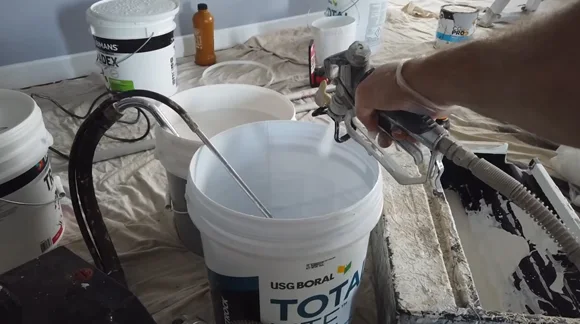
Gather Necessary Cleaning Supplies to Clean the Area
Gather the necessary cleaning supplies before using a paint sprayer to spray drywall mud to ensure a good-looking and professional end result. The following items should be gathered beforehand:
The vacuum is the first item necessary for cleaning after spraying drywall mud. Attachments may include an upholstery attachment as well as a crevice tool. The vacuum should have wet or dry capabilities.
In addition to the vacuum and its attachments, rags and towels can be used to wipe up spills and catch drips from the sprayer. Several buckets are also beneficial, as they can collect dirt from power sanding or muddy water.
Various tools, including sponges, brushes, and scrapers, can be used to clean drywall mud off of walls and ceilings. Protective gloves and goggles should be worn when dealing with potentially hazardous materials like drywall dust particles or harsh chemicals like cleaners or degreasers.
Finally, cleaners such as mild soap and degreaser can be used to remove stubborn residue after spraying drywall mud on with a paint sprayer. However, it is important to ensure these products will not damage the surface before beginning this step in the process.
Additionally, it is always recommended that one reads all product labels carefully before use, as some products may contain harsh chemicals that could harm the skin if not properly handled.
Ensure Adequate Ventilation in the Area
Ensure adequate ventilation when spraying drywall mud via a paint sprayer in order to avoid respiratory irritation.
This can be done by opening windows and doors or running exhaust fans and by wearing a face mask or respirator if necessary.
Another way to improve ventilation is by using an air filtration system such as a HEPA filter fan.
How Do You Get A Smooth Texture On Spray Paint?
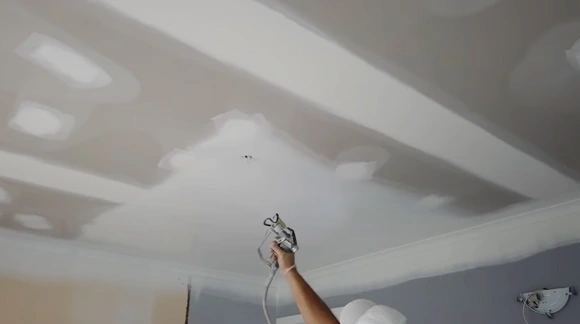
To achieve a smooth texture when spray painting with drywall mud, you will need to adjust the pressure of your paint sprayer to get the desired effect. Start by turning down the pressure as low as it can go and test spraying on a scrap piece of cardboard or paper.
If you want a finer, smoother texture, slightly increase the pressure until it sprays in a uniform pattern. You may also need to adjust the nozzle settings to get a more consistent finish.
Do I Need To Prime Before Spraying The Texture?
Priming before spraying with drywall mud is not necessary but is recommended for better results. Primer will create a layer between the wall and the drywall mud, which helps reduce the absorption and adhere better.
It is also especially important when using light colors since primer helps prevent discoloration from excess moisture or other contaminants in the wall surface.
Can I Use Paint Thinner Instead Of Mineral Spirits?
A paint thinner cannot be used instead of mineral spirits when using a paint sprayer to apply drywall mud because it will clog up the nozzle over time due to its thick viscosity. Mineral spirits are generally recommended for this application as they thicken up less quickly and won’t block your nozzle as easily.
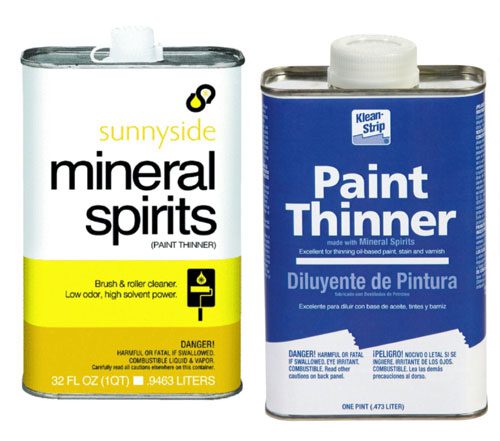
What Is The Petroleum Jelly For On A Paint Sprayer?
Petroleum jelly can be used on a paint sprayer when spraying drywall mud to help lubricate the internal parts that may become stuck or clogged over time due to the excessive buildup of mud particles inside the paint gun’s body.
Applying petroleum jelly around seals, O-ring connections, and other openings can help ensure that these parts don’t become jammed over time and help keep your painter functioning properly for extended periods of time.
Can I Use Vinegar In My Sprayer?
Vinegar should not be used in a paint sprayer when using drywall mud as an additive because it will cause corrosion inside your gun due to its acidic nature.
The vinegar particles may also mix with the drywall mud creating an uneven texture on your walls which could lead to an unsatisfactory finish in terms of aesthetics and performance.
Do Professional Painters Use Sprayers?
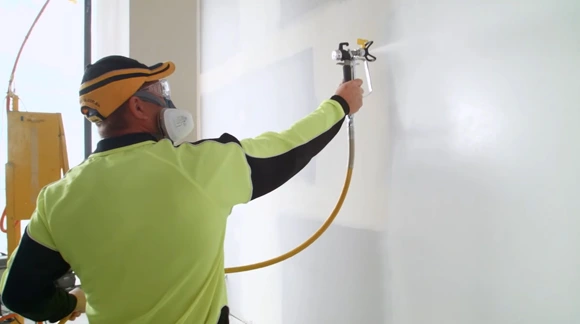
Many professional painters use paint sprayers for applying their coatings because it is often faster than painting with brushes or rollers and gives them greater control over their material when applying textures or intricate designs on walls or ceilings.
Professional painters usually use high-quality guns that are specially designed for spraying heavier materials such as joint compounds, plaster, and stucco mixtures to obtain optimal results quickly without any hassle.
Do I Need To Backroll After Spraying The Interior?
Yes, you will need to backroll once you’ve finished spraying the interior of your walls. Backrolling is the process of using a roller to spread out the paint and create an even finish. This will help reduce brush strokes, help eliminate air bubbles, and ensure a smooth and uniform finish.
Is It Worth Using A Paint Sprayer?
It is worth investing in a paint sprayer for drywall mud as it can save you time and produce a much better finish than traditional methods like rolling or brushing.
Paint sprayers create less mess than other methods due to their ability to apply an even coat in one pass. As well, the application is faster, which means you can cover large areas quickly and with minimal effort.
Does A Paint Sprayer Use More Paint Than A Roller?
Paint sprayers tend to use more paint than rollers due to overspray and wind-induced wastage.
However, compared to other types of painting methods, such as brushing or rolling, paint sprayers use about the same amount of paint with less wastage overall.
It’s important to choose a high-quality sprayer that will provide an even coat without too much overspray.
Can You Use A Paint Sprayer For The Interior Walls?
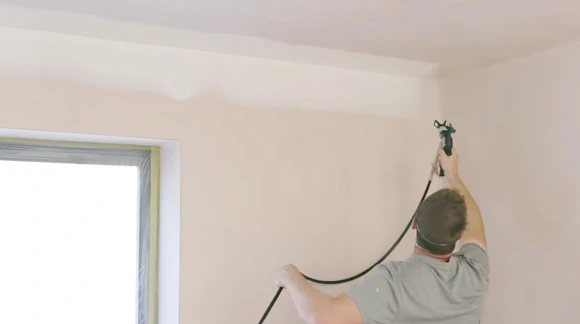
Yes, for your interior walls you can make use of a paint sprayer. It’s important to be mindful of proper safety measures when spraying indoors as there is hazardous over-spray caused by the atomization process that needs to be managed correctly.
Additionally, some types of finishes may require you to use a specific type of tip size on your sprayer, so make sure you have the right ones handy before beginning your project.
Do I Need To Water Down The Paint For The Sprayer?
When you are paint-spraying drywall mud, it is not necessary or recommended to water down the material before spraying it through your machine.
The finer particle size of drywall mud helps it flow more easily through the gun, so no thinning agent is needed here simply pour it directly into your hopper and start spraying.
However, if you find that your material isn’t flowing efficiently, then adding small amounts of water should help improve its consistency and performance in your machine.
Final Comments
Using paint sprayers to apply drywall mud may seem intimidating at first glance. But with some practice and preparation, it can be done successfully. Now that you know more about how to spray drywall mud through a paint sprayer, you should feel much more comfortable giving it a try on your next project.
Spray drying is an efficient way to apply joint compound as it allows you to cover large areas quickly and evenly with minimal effort compared to other methods, such as rollers or brushes.
It helps reduce the overall time spent on wall-finishing tasks significantly, making it an attractive option for anyone looking for faster results when working on their walls.
With all the benefits of using this method, though, there are drawbacks, such as limited control over where the material goes or difficulty cleaning up after yourself afterward.
Ultimately though, if you take some time to practice first, then decide if splashing drywall mud through a paint sprayer is something you’d like to try out in your next project.



